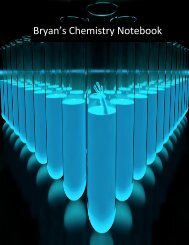You also want an ePaper? Increase the reach of your titles
YUMPU automatically turns print PDFs into web optimized ePapers that Google loves.
Explanation: With the addition of the catalyst it will allow the amount of energy required to be less<br />
than what it was originally was. Resulting in an increase rate of the reaction.<br />
3 For the reaction<br />
A + (aq) + B — (aq) → AB (s)<br />
Increasing the temperature increases the rate of the reaction. Which is the best explanation for this<br />
happening?<br />
A The pressure increases, which in turn increases the production of products.<br />
B The concentration of reactants increases with an increase in temperature.<br />
C The average kinetic energy increases, so the likelihood of more effective collisions between ions<br />
increases.<br />
D Systems are more stable at high temperatures.<br />
Explanation: When you increase the surface area, more of the substances is exposed to particles<br />
which in turn will increase the collision of particles that cause the reaction. Therefore, this will result in<br />
an increase in the speed of some reactions. Particles can only react when they collide. If you heat a<br />
substance, the particles move faster and so collide more frequently. That will speed up the rate of<br />
reaction. Collisions only result in a reaction if the particles collide with enough energy to get the<br />
reaction started. This minimum energy required is called the activation energy for the reaction.<br />
4 Which statement explains why the speed of some reactions is increased when the surface area of<br />
one or all the reactants is increased?<br />
A increasing surface area changes the electronegativity of the reactant particles<br />
B increasing surface area changes the concentration of the reactant particles<br />
C increasing surface area changes the conductivity of reactant particles<br />
D increasing surface area enables more reactant particles to collide<br />
Explanation: The more finely divided the solid is, the faster the reaction happens. A powdered solid<br />
will normally produce a faster reaction than if the same mass is present as a single lump. The<br />
powdered solid has a greater surface area than the single lump. You are only going to get a reaction<br />
if the particles in the gas or liquid collide with the particles in the solid. Increasing the surface area of<br />
the solid increases the chances of collision taking place. Increasing the number of collisions per<br />
second increases the rate of reaction.<br />
catalyst<br />
C6H6 + Br2 → C6H5Br + HBr<br />
5 Which of the following changes will cause an increase in the rate of the above reaction?<br />
A increasing the concentration of Br2<br />
B decreasing the concentration of C6H6<br />
C increasing the concentration of HBr<br />
D decreasing the temperature<br />
Explanation: The same argument applies whether the reaction involves collision between two<br />
different particles or two of the same particle. In order for any reaction to happen, those particles<br />
must first collide. This is true whether both particles are in solution, or whether one is in solution and<br />
the other a solid. If the concentration is higher, the chances of collision are greater. For many<br />
reactions involving liquids or gases, increasing the concentration of the reactants increases the rate<br />
of reaction. In a few cases, increasing the concentration of one of the reactants may have little<br />
noticeable effect of the rate.<br />
143




